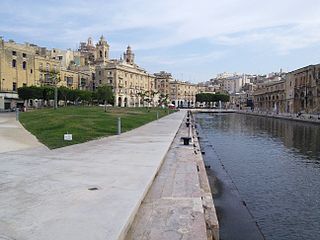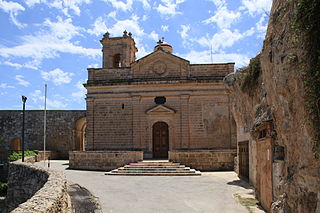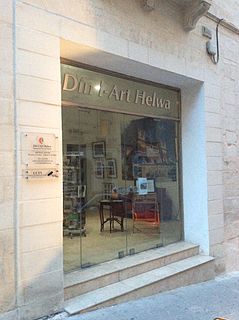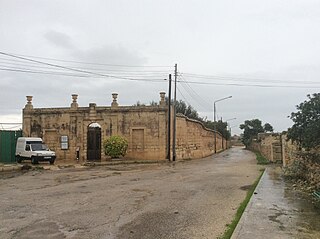
Safi is a village in the Southern Region of Malta, bordering Żurrieq and Kirkop. It has a population of 2,126 people as of March 2014.

Leonard of Noblac, is a Frankish saint closely associated with the town and abbey of Saint-Léonard-de-Noblat, in Haute-Vienne, in the Limousin (region) of France. He was converted to Christianity along with the king, at Christmas 496. Leonard became a hermit in the forest of Limousin, where he gathered a number of followers. Leonard or Lienard became one of the most venerated saints of the late Middle Ages. His intercession was credited with miracles for the release of prisoners, women in labour and the diseases of cattle.

Cospicua, also known by its titles Città Cospicua or Civitas Cottonera, is a double-fortified harbour city in the South Eastern Region of Malta. Along with Birgu and Senglea, it is one of the Three Cities, located within the Grand Harbour to the east of the capital city Valletta. With a population of 5,395 as of March 2014, it is the most dense city of the Three Cities.

Gudja is a village in the Southern Region of Malta, with a population of 3,148 as of March 2017. The village is located on high grounds, south of Valletta. It is administered by the Gudja Local Council. A number of schools, clubs, public gardens and recreations places are found around the village. The Malta International Airport is also located in Gudja.

Kirkop is a village in the Southern Region of Malta. It is found near the Malta International Airport, and has been inhabited since pre-history. The parish church is dedicated to Saint Leonard. The football team of the village is the Kirkop United Football Club.

Naxxar is a town in the Northern Region of Malta, with a population of about 13,443 people as of March 2014. The Naxxar Church is dedicated to Our Lady of Victories. The annual village feast is celebrated on 8 September. Naxxar was formerly known for hosting the Maltese International Trade Fair at Maltese International Trade Fair Grounds.

The Sanctuary of Our Lady of Mellieħa is a Roman Catholic church in the village of Mellieħa in Malta. The sanctuary originated as a natural cave which was consecrated as a church at an unknown date, and local traditions link its establishment to antiquity or the medieval period. The church's altarpiece is a Byzantine-style fresco which is believed to date back to the late 12th or early 13th centuries, and it is said to be miraculous.

Malta is subdivided in districts of localities in order to administer the country in regions rather than locality. The districts have no administrative significance as the local councils provide the first-tier divisions of the country.

St. George's Basilica or the Basilica and Collegiate Parish Church of Saint George, also simply known as San Ġorġ in Maltese, is a historic Baroque church situated in the middle of Victoria, the ancient "Ħaġar" – the capital of Gozo, the second largest island in the Maltese archipelago, and is surrounded by a maze of old narrow streets and alleys. Today's basilica was built between 1672 and 1678.

In the small Mediterranean island nation of Malta the predominant religion is Roman Catholicism.

Din l-Art Ħelwa is a non-governmental and non-profit, voluntary organisation founded in 1968 by Maltese Judge Maurice Caruana Curran to safeguard Malta's cultural heritage and natural environment. Since its foundation, Din l-Art Ħelwa has restored numerous cultural sites of historic and environmental importance. The organisation promotes the preservation and protection of historic buildings and monuments, the character of Malta's towns and villages, and places of natural beauty. They stimulate the enforcement of existing laws and the enactment of new ones for the protection of Malta's natural and built heritage.

The Chapel of St Mary is a medieval chapel located in Bir Miftuħ, limits of Gudja, Malta.

The Parish Church of St Andrew is a Roman Catholic parish church located in Luqa, Malta.

St Basil's Chapel is a Roman Catholic medieval church located in Mqabba, Malta. It is the only church building in Malta dedicated to St Basil the Great.

The Chapel of St John the Evangelist is a small Roman Catholic church located in the now uninhibited area known as Ħal Millieri which today forms part of the village of Żurrieq in Malta.

The Parish Church of St Leonard is a Roman Catholic parish church serving the village of Kirkop in Malta.

The Archpresbyterial and Archmatrix Church of the Assumption of Mary also simply known as St Mary's Parish Church is a Baroque Roman Catholic parish church serving the village of Gudja, in Malta.

The Ġonna tal-Kmand, formerly known as Ġonna tal-Kutnent and sometimes known as Ball Gardens, are a group of gardens in various localities in Malta, which were built in the early years of the 19th century when the island was a British protectorate. The gardens were commissioned by Civil Commissioner Alexander Ball between 1802 and 1805, and were given to the Luogotenenti in charge of the towns or villages.
Stefano Erardi (1630–1716) was a Maltese painter whose works may be found in many churches around the Maltese Islands. His style has been described as either late Mannerist or Baroque.
The Old Church of St Domenica is a ruined Roman Catholic parish church in Dingli, Malta, which was dedicated to Saint Domenica.

















